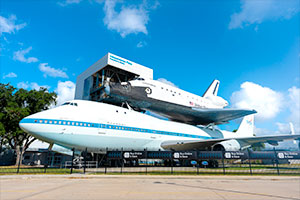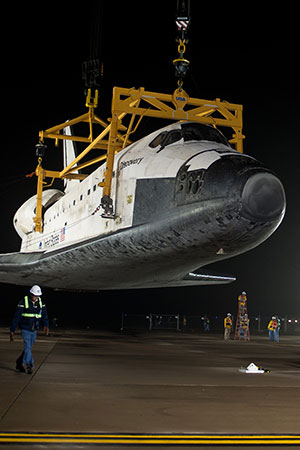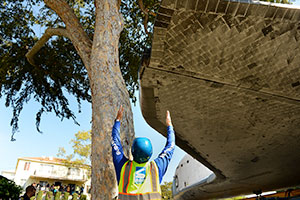April 10, 2025 — NASA's retired space shuttle Discovery may be removed from the Smithsonian and put on display in Houston, if two lawmakers from Texas get their way.
U.S. Senators John Cornyn (R-TX) and Ted Cruz (R-TX) on Thursday (April 10) introduced the "Bring the Space Shuttle Home Act," which directs NASA to take Discovery from the national collection and its Virginia home of the past 13 years and deliver it to official visitor center for NASA's Johnson Space Center.
"It is past time that the Space Center Houston museum houses a space shuttle, given the unique relationship between the entire program and its support staff in Houston," said Cruz, who chairs the Senate committee that has oversight of NASA. "Bringing the Discovery to its final home will offer hundreds of thousands of visitors each year the opportunity to engage with a living piece of NASA's history and understand why Houston is known worldwide as 'Space City.'"
On April 12, 2011, NASA announced that it was awarding its winged orbiters to museums in California, Florida, New York and Virginia. While Atlantis, Endeavour and the prototype Enterprise went on display for the public's education and enjoyment, Discovery — the oldest remaining, space-worthy orbiter in the fleet — was identified as the agency's vehicle-of-record and entered the Smithsonian so that it could serve the additional purpose of supporting future research and study.
"We spent a lot of time and money to preserve Discovery in as near to flight condition as we could to put it in the national collection, so that any future engineer or historian has a reference vehicle to look at, measure or do whatever they need," Dennis Jenkins, a former space shuttle engineer who was the director of NASA's transition and retirement program at Kennedy Space Center in Florida, said in an interview with collectSPACE.
Mission impossible?
The "Bring the Space Shuttle Home Act" provides 90 days from the date of its enactment for NASA to submit a report about how it would conduct the move and then 18 months to complete the transfer. Discovery's original delivery to the Smithsonian National Air and Space Museum's Steven F. Udvar-Hazy Center took years of planning and required hardware that either no longer exists or can no longer be used without a lot of work.
"One problem is that we have no ground support equipment remaining on the planet to lift it, to install a tail cone or do anything else to prepare for its move. All of that hardware was destroyed after space shuttle Endeavour was stacked," said Jenkins, who today is director of Endeavour's exhibit at the California Science Center in Los Angeles. "We also have no meaningful method of transportation, since neither of the shuttle carrier aircraft are currently operable."
NASA had two modified Boeing 747 jetliners that were used to ferry the shuttle orbiters across the country. One today sits on display at Space Center Houston and is no longer flightworthy. The other is at an air park in Palmdale, California. It had its orbiter attachments removed, needs new engines and would have to be recertified to return to flight.
Moving Discovery by land would require a tremendous undertaking — if is even possible. The relatively short-distance roadtrip that Jenkins oversaw to transfer Endeavour from Los Angeles International Airport to the California Science Center in 2012, proceeded at a glacial pace and stretched into three days while trees had to be cut back and traffic lights lowered.
Partially disassembling Discovery is also not an option. Removing the wings would result in destroying many of the thermal blankets and tiles that protected the space shuttle as it returned to Earth, and you would still be left with segments too large to enter normal traffic, explained Jenkins.
What about moving it by water? Ignoring that the closest waterway, the Potomac River, is located almost 30 miles (48 kilometers) from the Udvar-Hazy Center, it would likely require a new, enclosed barge to be designed and built.
"In an open barge, it wouldn't survive the trip," Jenkins said, "and in an enclosed barge large enough to hold Discovery, you would probably stand some risk of losing it in a storm. Even if you were really careful when you moved it, the risk would never be zero."
Were it possible to overcome some or all those obstacles, there would still be the matter of the cost. The bill leaves funding of the move to the NASA Administrator using the agency's existing budget without any guarantee of additional allocations by Congress.
"I can easily see this costing a billion dollars," said Jenkins.
Politics vs. posterity
It is not clear what inspired Cornyn and Cruz to introduce this legislation now. Space Center Houston was not consulted and only learned of the proposed move after it was first reported by the Houston Chronicle on Thursday (April 10).
"We're learning the details along with everyone else," said Keesha Bullock, chief communications and marketing officer and interim chief operating officer at Space Center Houston. "We were not part of the development of the legislation, but we welcome the conversation."
According to Bullock, displaying Discovery would not interrupt Space Center Houston's existing expansion plans, but it was too early to say where it would be displayed or how its exhibit would underwritten.
A Senate press release stated that the bill was motivated in part by the Obama administration having "played politics to keep Houston from getting one of the shuttles."
"It is clear political favors trumped common sense and fairness when the Obama administration blocked the Space City from receiving the recognition it deserves," said Cornyn in a statement.
This is not the first time that such a claim has been made, but no evidence has been put forth to support such, said Jenkins.
"To my knowledge, both the released documentation and lots of conversations with the people involved in the process, there was no pressure from the White House in any regard as to where the orbiters should or should not go," Jenkins told collectSPACE. "The other locations were clearly superior to any place else in all of the criteria."
Space Center Houston's original proposal more than a decade ago was to put the orbiter in a hangar. It lacked any of the immersive features that the California Science Center or Kennedy Space Center Visitor Complex had planned, nor did it reach (at the time) the number of annual visitors that the Intrepid Museum had in Manhattan.
Bullock said that for Space Center Houston, the question is not one of politics, but history.
"Houston led the shuttle program, trained the astronauts who flew on its missions and was the response team for all of the triumphs and tragedies that happened with Discovery," she said. "Bringing it here, from our viewpoint, honors that legacy." |
|

Since 2012, the space shuttle Discovery has been the centerpiece of the James S. McDonnell Space Hangar at the Smithsonian National Air and Space Museum's Steven F. Udvar-Hazy Center in Chantilly, Virginia. (Smithsonian/Dane Penland)

NASA's original Shuttle Carrier Aircraft (NASA 905) is now display at Space Center Houston and no longer flightworthy. It is exhibited with the mock orbiter Independence. (Space Center Houston)

Ground support equipment, such as the yellow sling seen here attached to Discovery, was needed to lift the space shuttle orbiters for their moves. The hardware no longer exists. (NASA/Bill Ingalls)

Clearances were often tight when moving space shuttle Endeavour through Los Angeles streets in 2012. (LA Times/Wally Skalij [Pool])

Space Center Houston's original proposal for the display of a space shuttle was simple compared to more immersive exhibits put forth by the other museums and visitor centers. (Space Center Houston) |
